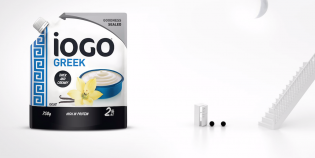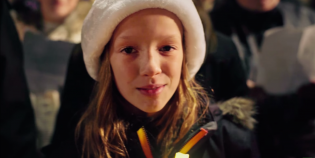In the massive yellow-walled main hall of the Palais des Festivals et des Congres de Cannes, the 56th International Advertising Festival has set up its gallery of submissions. Attendees from 86 countries move silently past print and promo ads as though they were in a museum. Some take photos or video of the ones they like. Some just stroll, looking for inspiration to take home. Despite the bustle of the Cannes Lions festival, the area is still, like a church.
Four floors above, the Palais is anything but church-like. In smallish, cinder block rooms with fluorescent lighting, juries are engaged in heated debates as they whittle down 22,652 entries into short lists and winners’ lists of bronze, silver, gold and Grand Prix awards. From early morning to late night, the 11 juries (made up of 209 of the best creative minds in the business) eat, sleep and breathe advertising. And it ain’t all pretty.
|
CANADIANS IN CANNES
Canada won 13 Lions at the 56th International Advertising Festival in Cannes this year, an improvement from last year’s haul of nine Lions |
|
Gold:
Leo Burnett and James Ready won in the Outdoor competition for the”Share our Billboard” campaign Taxi and Pfizer’s most recent work for the Viagra brand won in the Film competition |
|
|
|
Silver:
Sid Lee’s self branding effort took a Design Lion Cossette added a Film Lion to its trophy cabinet for the Pizza Pops campaign for General Mills “Scooter” for the Canadian Film Centre earned Doug Agency a Film Lion |
|
|
|
Bronze:
Cossette’s Yellow Pages campaign earned a Media bronze; the agency also won in the Design competition for client Enablis DDB’s Vancouver office landed a Lion in the Design competition for Silver Hills Bakery packaging GJP was awarded a Lion in the Design competition for client Roland Semprie Kraft’s quirky Diamond Shreddies creative earned Ogilvy & Mather a Bronze Lion in the Film competition BBDO’s”Taxi” spot for Tropicana Tropics won in the film competition Leo Burnett’s radio campaign for P&G’s Gain brand won bronze In the Cyber competition, Vancouver’s Noise Digital brought a Lion for a website for Nokia’s”Resident Evil” game |
“People typically enter a lot of shit in this show,” says Janet Kestin, the co-creative director from Ogilvy & Mather Toronto who has been watching an unending stream of television ads on the Film jury. “We did see a lot of diabolical stuff. The first few days, everyone is tired and depressed. But because the economy is shitty, people entered less bad stuff than previously. People were a lot more careful about what they entered. It forced you to concentrate on how you were spending your money. That was a good thing for us.”
Juries must sort the original from the derivative, the fakes and the dog-walkers to award only the world’s “best” work because this isn’t just any awards show. It’s the Cannes Lions, and the stakes are high. Especially this year.
Lion-winning work defines what is “good” for the year. A Lion can mean more business for an agency, which in a downturn can prevent layoffs and closures.
“What you want to do is set a bar,” says Matthew Bull, South Africa-based chief creative officer at Lowe Worldwide and Radio jury president. “I’ll have my guys back at the agency writing ads going ‘That could win a Bronze Lion because I’ve heard a Bronze Lion before.’ That’s fine, but I want a Bronze Lion to be really [high quality]. That will be good for our clients.”
Defining “good” is a convoluted process. Trying to determine the quality of creativity and strategy is one thing, but doing so with countries and other judges looking over your shoulder is quite another. As Canadian judges in Cannes will discover, getting through the week takes more than a simple show of hands.
Early on the first judging day, before the crowds hit La Croisette, Cannes judges made their way westwards from swanky hotels like The Carlton to La Palais. The festival arranges rides in minivans, but many choose to walk to get a bit of sunshine before the daily grind begins.
Once everyone arrives, each jury’s president will lay down the criteria for judging and set the tone for the week. “The organizers of the show come and say ‘this is not about banding,’ tell you you have to be impartial and so on,” says Lisa Greenberg, a partner at GJP Advertising + Design and a jurist in this year’s Design competition.
Each judge is then given a digital keypad to record their vote for each submission. At this stage, numerical scores determine whether an ad will progress to the next level of consideration–zero to three takes it out of contention, four to six means it’s short list material, and seven to nine means medal contender.
Juries range in size from Titanium & Integrated’s 10-member team to Direct’s 31. Most juries get split into groups for the first few days with work divided evenly among them. At this stage the work is anonymous in terms of submitting company and country.
Greenberg’s Design jury will assess more than 1,100 entries over the first three days of judging, ranging from posters to bread packaging. Kestin’s Film jury will see more than 3,400 ads. Given the current state of television and video advertising, this means anything from one-second Superbowl ads for Miller High Life to Stella Artois’ four-minute “Vingt-Quatre Heures.”
“We were in two different rooms, split into three groups,” Kestin says. “Over the first three days, I probably saw about 1,200-1,300 pieces of work. Jesus, it’s not a very attractive room.”
The Press and Outdoor judges constantly move from table to table to view submissions. Film and Cyber juries must sit and stare at monitors all day. Radio judges have their ads on a portable player, so they can go outside and recline in the sun, “but it gets pretty lonely,” says Jenny Smith, Radio jurist and creative group head at Target Marketing and Communications in St. John’s. Lunch is provided, allowing the different juries a chance to mingle in an impromptu dining room that serves themed meals every day. One day was Greek food, the next Mexican.
“When you break for lunch, you sit next to Gerry [Graf, chief creative officer, Saatchi & Saatchi] or David [Lubars, chairman, chief creative officer, BBDO North America], all the giants,” Greenberg says. “It’s incredible. You’re sitting in the presence of all these great creatives. It’s very healthy and nice. Everybody’s very open.”
After all the work has been seen once, the juries meet to discuss what’s left and prepare a short list. Countries and companies of origin are revealed. Judges are often surprised by what the first round of scoring has produced. Generally, each judge is allowed to pull one rejected submission off the death pile. This is where the hard debates begin, and where the process comes under scrutiny. “A few people brought back spots that I didn’t initially hear but I thought were great work,” Target’s Smith says. “I wondered what else I had missed out on.”
Smith would have preferred an extra day of judging to allow judges a chance at reviewing every submission at least once, a “grueling” but necessary proposition, in her opinion. In fact, every jury member interviewed for this story suggested it. “It’s hard work, but it’s what you’re here for,” says Stephen Jurisic, creative director at Toronto’s John St. and a Press jury member. “It would be nice to just see the full field of work.”
The short list debate also reveals how poor some agency submissions are. Many juries require materials beyond the ad itself: cultural explanations and translations, business metrics or a board summarizing the work.
If ancillary materials are missing or sub-par, great work can be brushed aside. For example, Greenberg says Alpina Farben’s room-sized wall calendar didn’t make the short list initially because it wasn’t presented well. “It was this giant thing sitting in the corner of the room,” she says. “We thought maybe it was part of the environment.” She and American judge Jennifer Morla from Morla Design spotted it and began a discussion. Morla brought it back to the short list, and it eventually won gold.

|

|
|

|

|
Greenberg chose to resuscitate Sid Lee’s branding package–a series of “fanzines” outlining the Montreal agency’s creative philosophy that, with her support, would go on to win silver in the Self-Promotion category.
Expecting judges to read such lengthy works among Design’s more than 1,100 submissions is asking a lot, though Sid Lee did send in a board to summarize them. It wasn’t enough, at first.
“No one was taking the time to get the essence of the project. I think [Canadians] need to look at how we enter things. Judges want to read a board that’s [succinct]. It can compromise you otherwise. We have a lot to get through, and it depends on when in the day you’re judging.”
Greenberg’s decision to resuscitate a Canadian entry may have raised the eyebrows of some of her fellow judges. Voting purely along national or company lines is a frequent charge at Cannes, and jurists are vigilant about bias.
“Some of the judges were voting as a block for their region,” says Jurisic of his 19-member Press jury. “Once it was obvious what they were doing, it was easy to stop. It’s a global jury, and they didn’t have the numbers to get stuff through if the rest of us didn’t want it there.”
“The only thing I can say is people gather up around countries,” says Philippe Meunier, a senior partner at Sid Lee who sat on the Direct jury. “All the Spanish [speaking] people come together… Being alone from Canada, it makes it kind of hard.”
Jury presidents are asked to warn jurors if such behaviour persists, but national block voting is merely the most visible kind. John St.’s Jurisic compares the jury experience to watching focus groups get swayed by persuasive or bully-ish members. Good work can be ignored if something else is championed by a dominant personality.
“If you’re the only one with your hand up, you have to be brave,” says Greenberg. “There was one entry I put my hand up for alone, and I felt pressure. It was for a gun company [Carl Walther] and other jurors said ‘We can’t have a gun company on the winners’ list.’ I thought, ‘Well, then we get into tobacco and alcohol and everything that isn’t ecologically correct.’ But it was beautiful. It was a great corporate identity.” Walther’s submission did not make the medal round.
Still, Greenberg is surprisingly frank about her patriotic tendencies in the jury room. She believes Canada’s jury representatives should be “noisier” about our nation’s work, provided they feel it’s worth advocating for. “You develop a pride in your country, not at the expense of looking like a fool because there are stupid things in the show,” she says. “We’re so polite, we can get overlooked. We’re up against fiery countries from Latin America, and the English, who are very articulate. It’s not about bragging at all.
“If you want to fight for your country, but the work is rubbish, no self-respecting person could do that. But when it comes down to [Canadian] work that’s strong, you know it from [being] out there in the market and you’ve lived with it for a year.”
Meunier agrees that lobbying for work you know first-hand can level a playing field, rather than skew it. “Look at The Great Schlep,” he says, referring to Droga5’s award-winning online spot that asked American Jews to travel to Florida to encourage their grandparents to vote for Barack Obama. “It was a cultural thing, and only Victoria [Azarian from Ogilvy & Mather New York] understood the impact of the campaign. We were the only two in the room who could really explain it.”
Smith, however, thinks such zeal can harm an entry’s chances. “I try to champion all the Canadian work in radio. I thought, for example, Leo Burnett’s Gain stuff deserved silver and not the bronze it got… But the jury head and other jurors are very aware of where the work comes from. You can’t be in there fighting for Canada’s stuff to be pushed further because you’ll be taken aside.”
Once the short lists are settled upon, few submissions are actually in medal contention. For example, Bull’s Radio jury, known as one of the toughest this year, had 1,153 submissions. Only 167 executions, 14%, made the short list. Titanium & Integrated had 403 entries, with only 23 executions making the short list (6%). At this stage, the debating gets even more intense as the list is refined into medal winners. Front runners for top prizes are given extra scrutiny, and little errors can sink an otherwise strong contender.
For example, Torsten Hennings was keeping his ears keen for good technical production in Radio’s final hours of deliberation. As a director and producer at Studio Funk Hamburg, “he’s not an agency guy, so he was invaluable,” says Smith. “We were listening to a few spots I thought deserved to win at least bronze. He pointed out little glitches in the production. I never would have noticed them.
“If you want to win here, you have to make sure your entry is brilliant on every level.”
Most juries have wrapped-up their winners’ list after five days (though Film, Titanium & Integrated can go to seven) with one final late night before the day of the awards ceremony. A morning press conference marks a jurists’ final responsibilities of the week when cameras capture the relief in their bleary eyes. Many are mere hours away from normal life and a beach vacation, and just have to face a room of pushy reporters before being allowed to join the real world.
Juries are almost all smiles once the cameras are turned off. Most are eager to explore the Palais, take in a seminar or visit the yellow-walled gallery where soon, the fruits of their labours will be visible in the rows of print and promo ads. After each award gala, small plaques appear next to the winning ads, announcing gold, silver, bronze or Grand Prix winners. The reverent visitors who silently stroll the aisles stop a little longer at these ads, take more photographs, trying to discern what made the judges pick these particular executions.
What’s “good” has been chosen for another year.
|
GRAND IN CANNES
 Barack Obama won again. The 2008 U.S. election was history-making for putting a black man in the Oval Office, but many marketing, media and advertising experts also hold up the campaign itself for redefining how elections can be won or lost in the Internet and social media era. Barack Obama won again. The 2008 U.S. election was history-making for putting a black man in the Oval Office, but many marketing, media and advertising experts also hold up the campaign itself for redefining how elections can be won or lost in the Internet and social media era. certainly the judges at cannes thought so, awarding the campaign both the titanium grand prix and the integrated grand prix. it was the first time one campaign has won both awards. Depending on who you ask, history was also made in the film competition with a two minute, 19-second made-for-the-web short film promoting philips’ cinema 21:9 lcd tv winning the grand prix. some pointed out it was the first time the award went to a spot that never ran on tv, though a grand prix was given in 2008 for microsoft’s long-form web films for the videogame halo 3 and in 2007 the film grand prix was given to the canadian “evolution”-a 75-second film that earned worldwide buzz online, not tv. The other big winner for the week was Tourism Queensland’s Best Job in the World campaign, winning Grand Prix in the Cyber, Direct and PR competitions. The campaign started with a simple want ad, but became a worldwide phenomenon. “What’s really impressive is the media reach,” said Philippe Meunier, Sid Lee creative and Direct judge. “It’s impossible to buy every country in the world, but because of the web it went viral.” |










